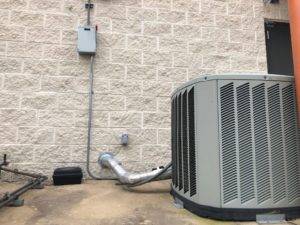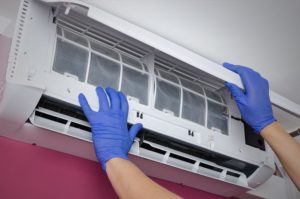Homeowners can choose from many types of air conditioners to satisfy budget and cooling needs. From whole-house systems that require professional installation to room-size and window units that set up in minutes, the many different types of air conditioners give plenty of choices.
Different Types of Air Conditioners You Can Buy
If you plan on buying a new air conditioner, here are your options:
Different Types Of Central Air Conditioning Systems
Most homes in the Valley of the Sun enjoy central air conditioning. Choose from two different types of central air conditioning systems – split- and single-unit.

Split system
Typically used in residential applications, this method separates the condenser and compressor outside; the evaporator is inside.

Single-unit
Generally seen in businesses with roof space to allow installation, single-unit AC systems combine the condenser, compressor and evaporator in one large cabinet.
Because these are very large pieces of equipment with many parts, their final assembly is done onsite. Rather than merely install a system, HVAC contractors really are the last step of the assembly line. They complete the assembly, attach the equipment to your home or business and balance everything. This is a complicated and exacting process requiring solid training and modern equipment. It is not usually within the skill set of the average homeowner or handyman.
Central air conditioning systems can easily handle cooling loads for an entire house. With regular maintenance and prompt servicing, they last at least a decade and typical lifespans can be 15 years. Even in difficult conditions such as those we encounter in Arizona, central air conditioners are rugged, reliable mechanisms for keeping cool.
Mini Split System Air Conditioning
When adding onto a home, you may not want to add cooling load to an existing central air conditioner system. This would require additional duct work, possibly a complete upgrade, and some major expenses. An alternative is a ductless mini split system, which is a small heat pump that attaches to an exterior wall.
A refrigerant line runs outside to a fan, allowing inside heat to be pumped outside. Cool air blows over the inside evaporator coils, providing plenty of cool air for a small space. You often see mini split systems in restaurants and small offices. They are efficient and generally reliable.
No additional ductwork is needed, saving the homeowner or small business owner a lot of money. Each mini split unit has a drain line outside to remove humidity from the air. Cooling power depends on the type of mini split system you buy, but do not expect one unit to equal the cooling abilities of an entire central air conditioner.
Heat Pump
If you are dealing with new construction, a heat pump is a possible alternative to a separate central air conditioner and furnace. Combining both cooling and heating, a heat pump literally pumps heat out of your home to cool it, and pumps outside heat into your home to warm it. A typical heat pump is not as capable of cooling as a dedicated central air conditioner, nor can it heat to the extent a furnace can.

Many people choose to depend on a heat pump for primary heating and cooling, supplementing with window air conditioners for additional cooling power (and often a small furnace for added heating). Heat pumps are extremely energy-efficient.
Smaller Air Conditioners
For single-room cooling, a convenient choice is a window air conditioner. It is only one option, though, along with:
- Freestanding, portable air conditioner;
- Wall-through air conditioner;
- Evaporative cooler.
Among types of window air conditioners, you can choose from tiny units intended to cool a very small space at low cost, or very large units that can tackle an entire great room, master bedroom suite or recreation room.
Many homeowners opt to have the flexible skirt that is attached to a window air conditioner replaced with a better-insulated, more permanent insert. This can add to the cost but greatly improve cooling. Heat cannot infiltrate as it can with the flimsy skirt and extensions on most window units. Insects are also less likely to find their way in with a better-quality replacement insert.
A wall-through unit will require major carpentry, which may mean hiring a professional to carefully measure location, determine no pipes or wiring runs through the area, and then cut a hole in your home’s exterior wall. The air conditioner then permanently resides in the framed-out hole, covered in the off-season on the outside. This frees up your window for viewing and light.
Evaporative coolers usually are small, portable units that work in a single room. Moist pads have air blown over them, causing the moisture to evaporate, cooling the room. In Arizona, these are good alternatives since our desert air is so dry. As the outside air is pulled into the home, it is moisturized and cooled. The fan also provides a pleasant breeze. Unfortunately, they do not work well during our summer monsoon season when humidity is much higher than the rest of the year.
Typical Costs for a New Air Conditioner
An Arizona homeowner asking, “How much does a new air conditioner cost?” can expect to hear a very wide range of answers, according to CostOwl:
Central air conditioner and furnace: You could pay up to $15,000 or even more for a complete split system.
Central air conditioner alone: Around $5,000 for a 2,000-square-foot home
Window air conditioner: 18,000 BTUs (British Thermal Units; the higher the number, the greater the cooling power) can run around $700; small units under 6,000 BTUs are available for as little as $200.
- Air source heat pump: Up to $7,500 using existing ductwork, far more if ductwork is required.
- Ductless mini split system: Up to $2,000 for a high-quality system.
- Evaporative cooler: Portable models can cost as much as $500.
Major Air Conditioner Manufacturing Brands
Many people swear they alone know the best air conditioner brand, but your choice is very personal. In general, all major brands of central air conditioners work from the same common parts (this is why a competent HVAC contractor can bring one small truck to your Arizona home and repair just about any brand of air conditioner).
The longevity of one brand or another is more dependent on overall design and its final placement than anything else. Installation is critical. A properly installed, less expensive central air conditioner can easily outlast a high-end model that was incorrectly or poorly installed.
Measuring Energy Efficiency
Among brands of portable units, such as evaporative coolers and window units, look for high Energy Efficiency Ratings (EERs); the higher this number, the less money you will spend to run the unit. You want to keep your cool when opening the electric bill each month, and a high EER will keep you from getting hot under the collar.
Energy Star is a federal program that helps consumers identify energy-efficient central air conditioners, window units and heat pumps. By following Energy Star ratings and guidelines, you can lock in savings that also:
- Lower greenhouse gas emissions;
- Decrease the need for more power plants;
- Reduce dependency on foreign energy.
Installing Your New Air Conditioner
Most homeowners cannot install complex systems like central air conditioners. To install them correctly, balance them for proper supply and return airflow, and tie them into the home thermostat and heating system, you need to contact an HVAC contractor. Even with window air conditioners, you can benefit from quick and helpful professional installation.
By contacting a reliable, local HVAC contractor like ACE Home Services, Arizona homeowners and business owners can get help with choosing, purchasing, financing and installing the ideal air conditioner for home or office. Contact the professionals at ACE Home Services today to learn more, and be sure to ask about current specials on AC tune-ups and new AC units.
See also: Prices of new air conditioners
